Varves as Records of Deglaciation
Varve chronology has become a useful tool in deciphering the history of deglaciation. Varve deposition is capable of recording the time of deglaciation, as well as other events related to ice recession, in varve years. With the calibration of varve chronologies it has become possible to determine the exact numerical ages for times of deglaciation and deglacial events.
Formulating the relative age of deglaciation in a glacial lake basin is based on either:
- matching varve records that have basal or ice-proximal varves as their base with an existing varve chronology
- placing the position of basal or ice-proximal varves in a sequence through counting relative to some well-marked isochronous horizon or bed of known age. Isochrons include basin-wide events in varve deposition caused by such things as flood events or volcanic ash deposition, bathymetric changes caused by lake level change, or sudden changes in sediment source for a basin.
or
Basal Varves
Basal varve localities are places where the bottom of the varve sequence can be found resting on till, bedrock, or a non-varved ice-proximal sand and gravel deposit that was formed at a receding ice margin or in a subglacial environment. The oldest or bottom-most varve in the sequence represents the first fine-grained lacustrine sediment deposited at the receding glacier front and very closely approximates the time of deglaciation, usually within a decade. Basal varves are often, but not always, thicker and coarser than overlying varves. In deeper lake basins, where calving and rapid ice recession may have occurred, it is not uncommon for basal varves to be relatively thin (<10 cm). Conversely, when varve deposition occurs close to the tunnel exit points of subglacial meltwater at the base of a submerged ice front, basal varves are likely to be very thick (>1 m) and composed of thick sandy summer layers that may have been deposited as a part of subaqueous fan deposits.
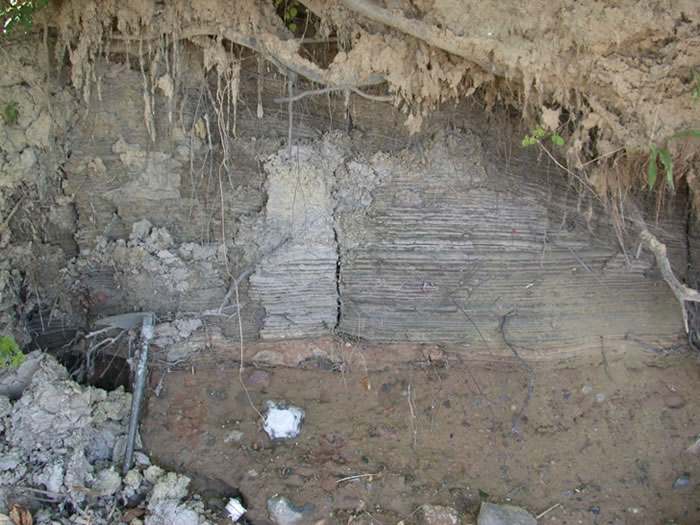
Basal varves overlying red till at Croton Point Park, Hudson Valley, NY

Sand in a basal varve resting on till in base of core at Clay Brook, Charlestown, NH
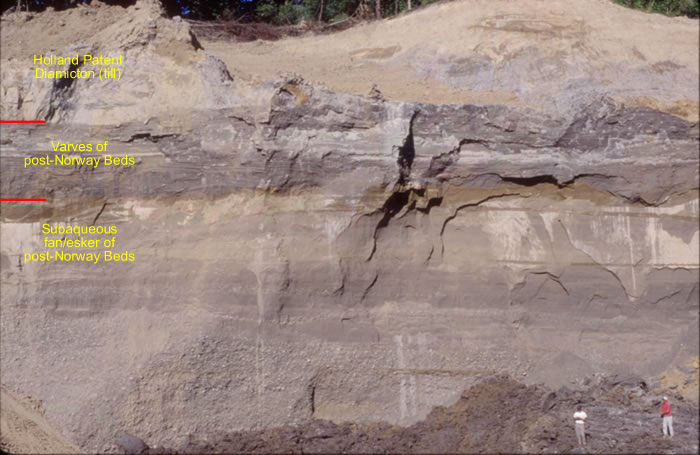
Basal varves in the post-Norway Beds (Ridge and others, 1990) west of Herkimer, NY in the western Mohawk Valley. The post-Norway Beds rest on upward fining sand and gravel of an ice-proximal fan/esker complex and are overlain by till (Holland Patent Diamicton) of a later readvance. The bottom varve in the post-Norway beds represents abandonment of the subaqueous fan by ice recession and closely approximates the time of deglaciation.
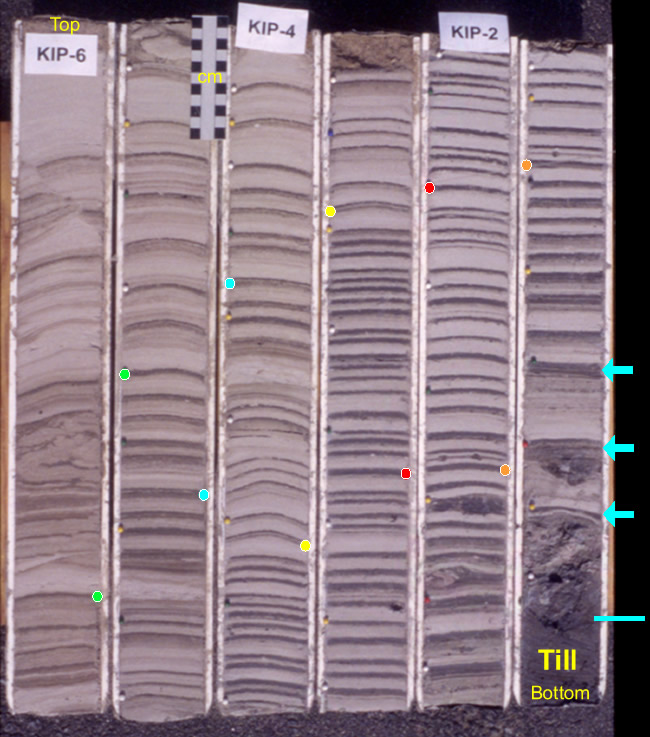
Basal varves overlying till at Keesville, NY in the Champlain Valley. The bottom three varves resting on till (arrows mark winter layers, right-most core) are very thick and sandy as compared to the sequence immediately above that shows a thinning of annual layers. Varves get progressively younger (right to left) in this sequence of over-lapping cores. Dots show equivalent layers on adjacent cores.
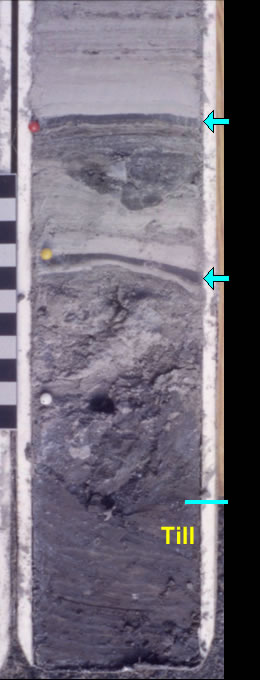
Close up view of basal varves overlying till at Keesville, NY in the Champlain Valley.
Ice Proximal Varves
Basal varve localities are sometimes difficult to find for study in larger lake basins without drilling. The bottom of most varve sequences often extends beneath stream deposits in the centers of valleys, can be buried beneath thick younger varve sequences, or may be covered by thick mass movement debris in surface exposures. However, we can still gather useful information on the age of deglaciation from ice-proximal varves in places where the bottom-most varve in a sequence is not exposed. Ice-proximal varves are distinguished by being very thick, coarse, and thinning upward. It is recognized that there may be more varves in the subsurface, but the average thickness of these varves dictates that there cannot be more than a few decades worth of sediment in the subsurface before hitting till, bedrock, or ice-proximal sand and gravel sediment. In this case the ice-proximal varves exposed at the land surface approximate the time of deglaciation within a few decades and are still useful for reconstructing the age of deglaciation.
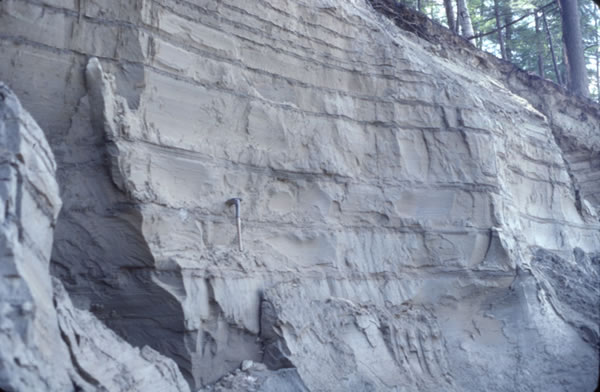
Ice-proximal varves north of Bellows Falls, VT in the Connecticut Valley. Note that varves thin upward with the bottom varve in this exposure (shovel is above the bottom varve) being over a meter thick. It may represent the later stages of subaqueous fan deposition from the nearby receding ice front. Shovel is 0.5 m.
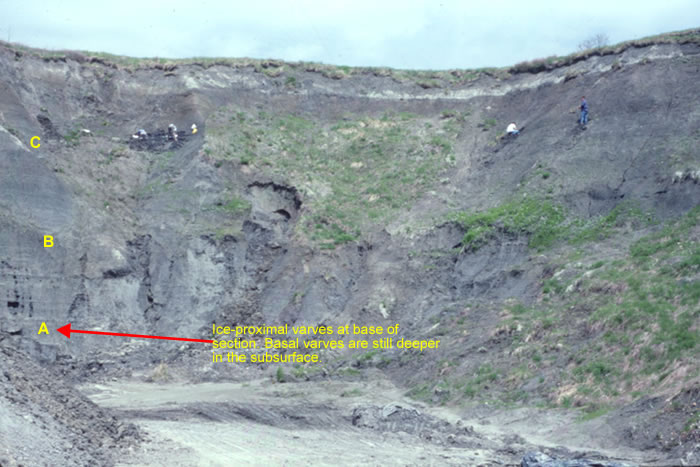
Varve Section at Canoe Brook, Dummerston, VT. Letters indicate approximate position of three images below that show the progression from ice-proximal (A) to distal (C) varves. Note people for scale.
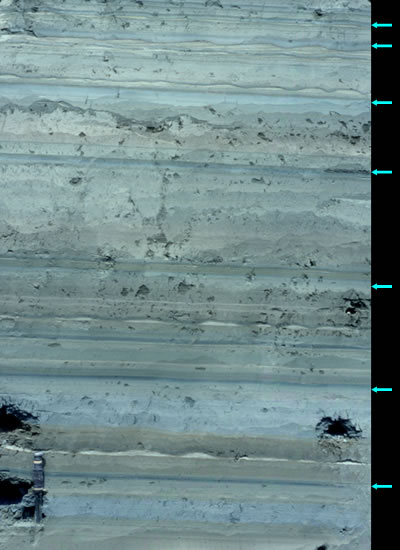
Ice proximal varves. Closeup of A in outcrop image above. Varves 7-12 above base of exposure. Thick (10-40 cm) sandy ice-proximal varves that thicken and become sandier downward. Knife handle is 10 cm.
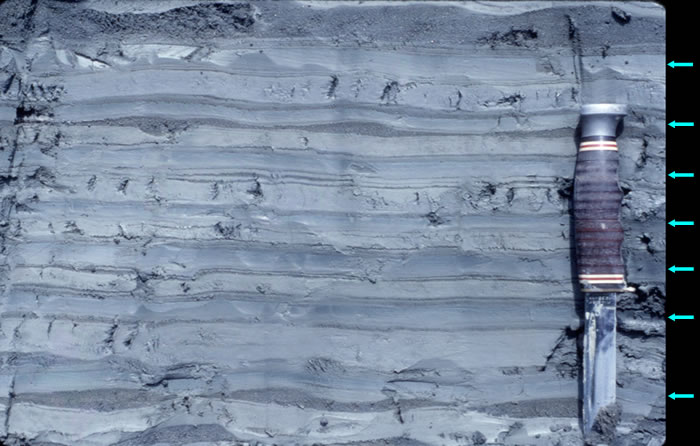
Transition varves. Closeup of B in image above. Varves 55-63 above bottom of exposure. Arrows show positions of bluish-gray winter layers. Knife handle is 10 cm.
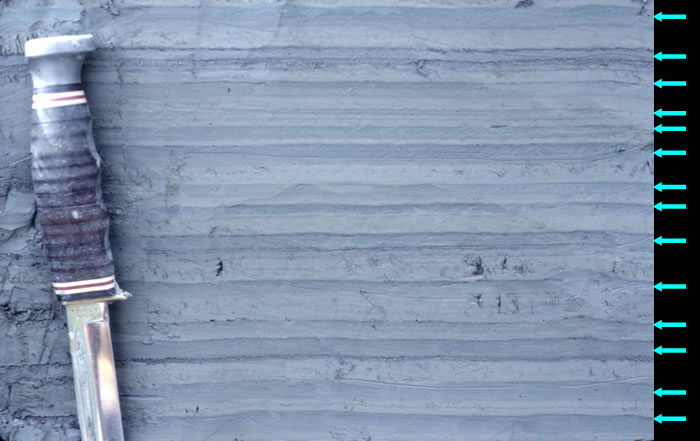
Ice distal varves. Closeup of C in image above.Varves 380-390 above bottom of exposure. These varves were deposited in a distal environment relative to the receding glacier. Arrows to the right point out bluish-gray winter layers in the varves. Knife handle is 10 cm.
Matching Basal and Ice-Proximal Varve Sections to a Varve Chronology
Where there has been a systematic recession of an ice front the ages of basal and ice-proximal varves get progressively younger in the direction of ice front retreat. The varves form an onlapping sequence above the glacial substrate as basal and ice-proximal varves get progressively younger during deglaciation.
The matching of varve sections, that bottom in either basal or ice-proximal varves, to a varve chronology can fix the approximate age of deglaciation at various points in varve years. In the example, the length of time required for deglaciation from the position of section A to section H is represented by the difference in age of the basal varves at A and H or the number of varves missing from the bottom of the record at H as compared to the varve record at section A.
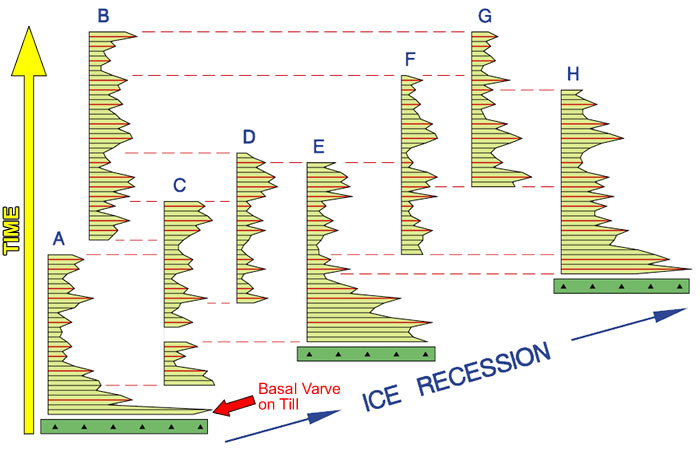
Determining the Relative Ages of Basal Varves (Onlapping Varves)
The relative position of basal or ice-proximal varves in a varve sequence at different places can be determined through counting up to some well-marked isochronous horizon or bed. Isochrons include easily recognized basin-wide events in varve deposition caused by such things as flood events, bathymetric changes associated with lake level change, or sudden changes in sediment source. In the example below, the recession from the position of section A to section D took 150 years.
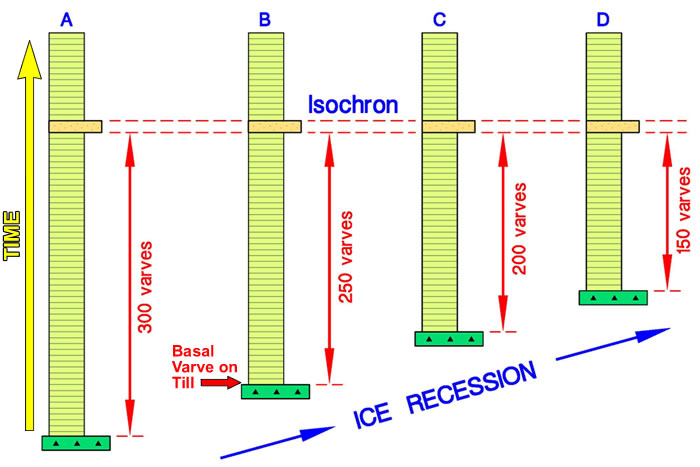
For the history of Ernst Antevs work on deglaciation go to History - North America. For the modern view of deglaciation in the northeastern U.S. vs. varve chronology go to NEVC Today - Deglaciation.
References
- Ridge, J.C., Brennan, W.J., and Muller, E.H., 1990, The use of paleomagnetic declination to test correlations of late Wisconsinan glaciolacustrine sediments in central New York: Geological Society of America Bulletin, v. 102, p. 26-44.


